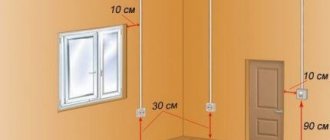After completing the work on marking the electrical wiring routes and installation locations for switching equipment, the stage of drilling niches for socket boxes or, as manufacturers correctly call them, round type-setting installation boxes without a lid begins.
In addition to the fastening function, they act as fireproof protection against fire, plus they provide the required level of insulation. Since walls are considered a conductive material, it is impossible to install sockets in them directly without these boxes.
But first, you need not to make a mistake with their choice.
Types of socket boxes
For concrete walls, a plastic version without presser feet is suitable.
Those that have such claws are used for plasterboard walls or plastic panels.
There are all-block options for different numbers of seats - from two to five.
Their main advantage is that they do not bend or deform during installation. Moreover, they can be used both in plasterboard and in a regular wall.
Well, the most scarce option today is a metal socket box for wooden walls. It can be either with or without a bottom.
If there is hidden electrical wiring in a wooden house, only such specimens are allowed to be buried in the tree.
The depth of the socket box also plays a role. It can be standard and in-depth.
Standard depth 45mm. Recessed version 60mm.
If you plan, in addition to the socket or switch itself, to also disconnect wires in it (soldering to other sockets, etc.), then you only need to buy a recessed one.
Tools and consumables
What tools are needed to install a socket box in a concrete wall?
- firstly, it is a powerful hammer drill (for SDS-plus or max shank)
- concrete drill with a diameter of 6mm
- protective glasses
- building level
- spatula for working with mortar
- a regular concrete bit with an SDS-plus shank - if you have a small amount of work and brick walls. The most optimal and budget option.
- regular concrete bit with SDS-max shank. Provided that you have a very large house, or walls made of high-quality concrete and an appropriate hammer drill.
- diamond bit for concrete for hammerless drilling with SDS-plus shank
A more expensive option, but it has its advantages:
1) the time of drilling the socket is almost the same as using an SDS-max bit 2) using a lightweight SDS-plus hammer drill - less tired hands, no shocks 3) less noise and dust during operation
Remember that diamond drilling excludes any impact mode. Only drill mode is allowed.
The instructions usually indicate for diamond core bits that they are intended for wet drilling. However, as practice shows, the wear of the crown, even during dry operation, is minimal.
In addition, when water is supplied, the slag can “knit” the crown. Crowns for drilling ordinary socket boxes, as a rule, should have a diameter of 68 mm.
If you do not want to hammer the installation box into a niche, but have space for its free installation and adjustment, then use a diameter of 72mm. For the block type, only these are suitable.
Some people use a diameter of 65 mm, after which they even manage to tightly insert a socket or switch directly into the resulting hole, spreading the product with its paws against a concrete wall or even drywall.
This cannot be done, as stated above, walls are considered conductive material.
If an RCD suddenly starts tripping in your house, one of the reasons for this may be the refusal to use socket boxes and installing sockets directly into the wall. Therefore, do not immediately blame the cable, but check the sockets first.
The PUE also speaks about the need to install socket boxes:
Making holes
This part of the work is the most difficult, long and dusty. Before it starts, you need to remove flowers, paintings and other small fragments of the interior from the room. Everything else must be covered with a protective film. You need to drill into concrete with the door closed, plugging the cracks with a wet rag.
You can drill a hole for a socket in concrete using one of the following methods:
Installing a hole for a socket using a puncher with an attachment
Using a special attachment for a puncher (crowns). The product consists of a shank, a steel cup with teeth and a central drill, which sets the correct direction of movement of the tool. During the drilling process, the bit gets very hot. To avoid burning the incisors, it must be periodically removed and cooled in water. After cutting into the concrete to the required depth, a cylinder remains in the hole. It is knocked out with a hammer and chisel, or destroyed with a hammer drill. You can knock out the entire cylinder with a powerful wedge and a sledgehammer. If the edges of the hole are damaged, it’s not a big deal - the wall will be plastered. Between the holes you need to make transitions for laying cables.
Pobedite tips
with a puncher. For work, a set of drills with a diameter of 6-12 mm and attachments for destruction are used. You can use a drill with a pobedit bit, but this is a very long and labor-intensive process. First, circles are drawn along which holes with a diameter of 6 mm are drilled at minimal intervals. After this, larger drills turn the internal space into a sieve. The final stage is the destruction, crushing and removal of the thin walls remaining after drilling. Here it will take more time to align the internal edges of the openings.
Cutting a hole for a socket with a grinder.
Grinder. Instead of a grinder, a hand cutter with a stone disc can be used. The choice in favor of this method is made in cases where the farm does not have a hammer drill, or for some reason it cannot be used. The outer edges of the drawn circles are connected by straight lines - a square or rectangle is obtained. Then the cutouts are made using a grinder. The circle should extend beyond the corners by half the diameter to obtain a properly shaped opening. To make it easier to select the material from the inside, it is recommended to make several additional longitudinal and transverse cuts. Breaking down and removing small fragments is faster and easier.
After receiving the holes, it is necessary to adjust them to the size of the socket boxes. To do this, use a manual or electric tool - a hammer drill, a hammer, a chisel, a straight grinder. Based on the results of the work, the holes should be 2-3 mm wider and deeper than the mounting boxes.
Niches need to be cleaned of stone chips and dust. It is advisable to treat them with a liquid primer to improve adhesion with the putty that will be used as a filler.
Rules for installing a socket box
The operating procedure is as follows:
- Using a d-6mm drill (or the same as on the crown), drill the center of the niches of future socket boxes (71mm between the “holes” if we are talking about a block)
Drilling depth - 5cm.
- Using the selected crown, drill out 5-10mm of concrete, after which the centering drill is pulled out from the crown
If you leave it, then when the hammer shakes during operation, the drill may become wedged and break off. In addition, when diamond drilling without impact, the drill will only smooth the concrete and interfere with the work.
- finish drilling the concrete with a crown to the required depth (about 5 cm)
The depth can be set in advance by placing the box on the bit and marking the required drilling distance with a marker.
When drilling, you need to rock the hammer slightly from side to side. This is necessary so that the sludge comes out and the crown does not jam. In this case, you need to adapt, since strong swaying also leads to a wedge.
This action greatly influences both the speed of operation and the increase in the service life of the product.
Metal hacksaw + diamond wire
The diamond wire cutting process may vary depending on how the rosette will be placed on the tile. If at the junction of two slabs, then they are applied to each other with their side edges. The glass of the socket box is installed in such a way that the tile seam passes through its center and is outlined along the contour. Each half is cut out using a hacksaw and string.
Before cutting a hole for a rosette in a solid tile, a hole is drilled into which the string is threaded. Next, cutting is performed in the manner described above.
Installation in high-strength concrete with reinforcement
If the concrete turns out to be highly durable, you start drilling and realize that this will take a long time, you can make your work much easier.
To do this, make several holes along the circle you started with an 8mm drill. You should end up with something similar to a revolver drum.
After this, continue with diamond or impact drilling. From there it should go like clockwork.
If you hit a large piece of reinforcement and you don’t want to ruin the new crown, then you can get out of the situation in two ways:
- switch the hammer drill to the chipper mode and knock it out with a chisel
True, this can greatly contribute to the appearance of new cracks in the plaster.
- remove a good crown and put in an old used one, then, without sparing it, chew through a metal rod (do not throw away the old ones, they may still be useful)
Knock out the concrete from the niche (using a chisel and hammer or a hammer drill), while providing a bevel for inserting the cable into the socket box.
Use a vacuum cleaner to remove all debris and dust.
How to seal a groove?
The final stage of work proceeds as follows:
- the grooves must be cleaned of dust; either a construction vacuum cleaner or an ordinary broom will do;
- grooves should be treated with a primer;
- to reduce the level of shrinkage, you can slightly wet the wall near the grooves;
- when everything is completely dry, cables and distribution boxes are installed according to the diagram;
- gypsum plaster is usually used to seal the grooves;
- To prevent the plaster layer from sagging and starting to collapse, you can use a reinforcing mesh.
Finally, let us note again. If you are not sure that you can do all the work yourself, it is better to immediately contact specialists.
The article was written for the site.
Tags:Electricity
Preparing the solution and installing it in a niche
The next stage is the installation of the socket boxes themselves in the prepared niches. You can install socket boxes on alabaster, putty or plaster.
The hardening time of the plaster is approximately four to five minutes. Of course, finishing the installation job in 5 minutes is not a problem. The main headache is the hardening of the prepared solution in a diluted container and the inability to use it for other work.
Therefore, to prevent the plaster from hardening too quickly, you can mix plaster (Rotband) into it. You will gain an extra 10-20 minutes. Add 2 parts putty to 3 parts plaster.
The plaster just holds much weaker. When hardening, the cement mortar shrinks, but the gypsum, on the contrary, expands slightly and securely clamps the socket box in the niche from all sides.
In order for alabaster and plaster to stick more firmly, the niche must be moistened. Use a sprayer or sprinkler.
Next, the socket boxes are prepared. If they are of a block type, then they are assembled into a block (2 pieces or more). The plug for the wire entry is cut off.
By the way, it is best to make a groove for the wire not in the center, but to the left or right of the hole in the wall.
Since the outlet hole in the socket itself is on the side.
The solution is poured into the drilled hole in the niche.
A socket box is inserted into the niche.
Everything is rubbed down with a spatula and the remaining mortar is removed from the outside.
The main task is to align and fix the socket box in its place. Make sure that its edges do not protrude from the wall.
Once the solution has set, you can remove all excess from the inside.
After finishing work, the sockets themselves are installed. This seemingly simple work also has its own rules and mistakes that can lead to irreparable consequences.
Preparatory work
Before starting installation work, you need to prepare tools and materials. You should decide on the areas where the sockets will be installed. It is necessary to draw a diagram showing the installation locations of sockets, switches and wire lines.
Note! In residential premises, it is customary to install sockets at a height of 30–40 centimeters from the floor. If we are talking about a bathroom, toilet, corridor or other room for utilitarian purposes, the level of fittings must be chosen based on practical need.
When laying wires, you should follow some rules:
- The wiring should be located 15 - 20 centimeters from the ceiling.
- The wires should only diverge vertically or horizontally. Building codes prohibit diagonal laying of wires, creating zigzags or twists between wires.
- The distance between the grooves and the gas pipeline should not be less than 35 centimeters.
Tools and materials
Installing a socket in a wall requires the following tools and materials:
- devices for creating grooves (grinder or wall cutter);
- hammer drill for drilling sockets;
- a crown for working with concrete, a Pobedit drill, a spatula-shaped attachment;
- knife, wire cutters, screwdriver;
- putty knife;
- roulette;
- plaster and alabaster;
- deep penetration primer composition;
- socket box;
- wires;
- pencil.











